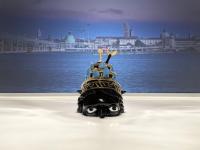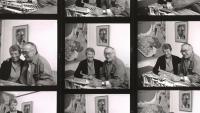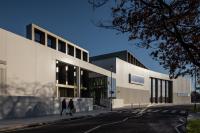Seestrasse
Berlin, Germany
Two seven-storey office buildings of the same size were built on the previously undeveloped site at Seestrasse 66-67 in Berlin-Wedding as an extension to the commercial location of the listed Osram-Hoefe. Both buildings were erected in reinforced concrete skeleton construction with load-bearing façades and an inner column grid.
The normal storeys of the building sections were given different beige and colourful façades made of clinker brickwork with differentiated divisions. The building section on the right-hand side of the street was provided with a two-storey base zone and a three-storey, vertically structured central area, to which the two-storey roof area with a titanium zinc pitched roof is connected. The building on the left also has a two-storey base area, but above it is a four-storey central area with glazed, large-format windows in segmental arches as a reference to early industrial modernism. This part of the building was given a staggered storey with a flat roof. Following the Berlin building tradition, the courtyard sides have a reduced design, with smaller window openings and a composite thermal insulation system façade with clinker brick slips in the same colour spectrum as the street façades.
Both houses are accessible from Seestrasse. From the courtyard side, there is the possibility of direct access to the staircases. This access route also serves as an entrance to the courtyard-side car park and as a fire brigade access road.
Each of the two buildings has a centrally located, external staircase with a double flight of stairs. The ground floors of both buildings can be reached barrier-free from the street and courtyard side via the single-storey lobbies. Well-dimensioned passenger lifts ensure barrier-free access to all floors of both buildings. These lifts are also accessible from the underground car park.
With the construction of the new office building at Seestrasse, the areas facing the street were also redesigned. Vegetation areas with tree and shrub plantings lend character to the inner courtyard. In addition, 64 above-ground car parking spaces and 32 bicycle stands were created here.
- Architects
- TCHOBAN VOSS Architekten
- Location
- Seestraße 66-67, 13347 Berlin, Germany
- Year
- 2020
- Team
- Architect: Sergei Tchoban, Project partner and leader: Philipp Bauer, Azzurra Pippia, Anja Schroth, Karsten Waldschmidt, Severin Burr, Valeria Kashirina
- General contructor
- Ed. Zueblin AG, Branch Brandenburg
- Landscape planner
- KUULA Landschaftsarchitekten, Berlin
- Structural engineering
- Weiske & Partner, Berlin
- Building equipment
- Marko Augustat & Partner Ingenieure zukunftsfaehiger Gebaeudetechnologie, Berlin
- Fire protection
- A-W-K Ingenieurgesellschaft mbH, Berlin
- Implementation planning for the GC
- Claus Neumann Architekten, Berlin
- Window design
- Metallbau Moeller GmbH & Co. KG, Erfurt
- Clinker brick façade construction
- Lutz Guettler GmbH, Bischofswerda





















